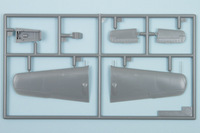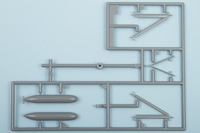
Hasegawa 1/72 Fw 190A-8 & Ju 88G-1 "Mistel S2"
By Chris Banyai-Riepl
Overview
One of the more interesting aviation operations during the Second World War was the Luftwaffe's Mistel program. This program placed a fighter aircraft, either the Messerschmitt Bf 109 or the Focke Wulf Fw 190, atop the Junkers Ju 88. The Ju 88 had its cockpit area replaced by a shaped explosive head, and the idea was to use the fighter aircraft to steer the aircraft to the target and break away once lined up. They were used during the Battle of Normandy and on the Eastern Front against the Soviet bridgehead at Küstrin. In both cases, the damage was negligible.
The Mistel program was given designations based on the aircraft used, and whether it was a trainer or an operational aircraft. The Mistel 1 used a Bf 109F-4 on a Ju 88A-4, while the Mistel 2 had a Fw 190A-8 or F-8 on a Ju 88G-1. The Mistel 3 was split into three main variants: the 3A (Ju 88A-4 & Fw 190A-8), the 3B (Ju 88H-4 & Fw 190A-8), and 3C (Ju 88G-10 & Fw 190F-8). The trainer versions had their designation prefaced by an 'S', so a Mistel S2 was an Fw 190A-8 or F-8 on top of a Ju 88G-1 that had a fully functional cockpit.
The Kit
Hasegawa continues to get as much mileage out of their superlative Ju 88 family of kits, so it is no surprise that they decided to tackle the Mistel. This kit combines the nice Hasegawa 1/72 Fw 190A-8 kit with their Ju 88G-1 kit, with the addition of the extra parts for the aircraft mount and support struts. These come in the form of both plastic and photoetch, and an added benefit the photoetch includes the very long ladder for the Fw 190 pilot. The decals provides markings for two Mistel S2 options.
The Fw 190A-8
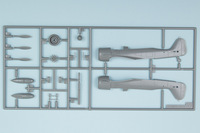 As there are essentially two kits in the box, the instructions are split up to cover the two different aircraft. They start out with the Fw 190, and this is a very straightforward build. The cockpit is molded as a one-piece tub, with a separate seat, control column, and instrument panel, the latter in two pieces. The side consoles and instrument panels are detailed with decals. With that done up, the fuselage gets buttoned up and the top cowling piece can be added. The front end has a separate cowl lip, with a separate impeller piece that gets separate propeller blades.
As there are essentially two kits in the box, the instructions are split up to cover the two different aircraft. They start out with the Fw 190, and this is a very straightforward build. The cockpit is molded as a one-piece tub, with a separate seat, control column, and instrument panel, the latter in two pieces. The side consoles and instrument panels are detailed with decals. With that done up, the fuselage gets buttoned up and the top cowling piece can be added. The front end has a separate cowl lip, with a separate impeller piece that gets separate propeller blades.
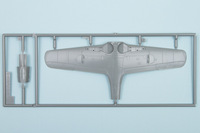
|
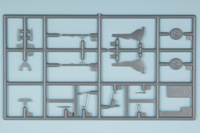
|
The Ju 88G-1
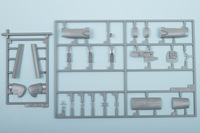 A more complex assembly, the Ju 88G-1 is a bit more detailed in the cockpit area than the Fw 190 kit (which is understandable, as the Fw 190 is an older tooling). The cockpit is built up around a separate forward nose section and includes a rear bulkhead, a floor, separate seats and instrument panel, four-piece rudder pedals, and a control yoke. Detailing comes from both painting and decals. This completed nose assembly then fits onto the rear fuselage assembly, which has two wing spars, the tailwheel, and upper fuselage antenna sandwiched between the halves. There is also a separate belly insert.
A more complex assembly, the Ju 88G-1 is a bit more detailed in the cockpit area than the Fw 190 kit (which is understandable, as the Fw 190 is an older tooling). The cockpit is built up around a separate forward nose section and includes a rear bulkhead, a floor, separate seats and instrument panel, four-piece rudder pedals, and a control yoke. Detailing comes from both painting and decals. This completed nose assembly then fits onto the rear fuselage assembly, which has two wing spars, the tailwheel, and upper fuselage antenna sandwiched between the halves. There is also a separate belly insert.
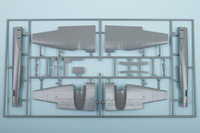
|
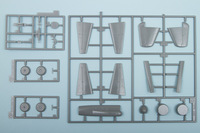
|
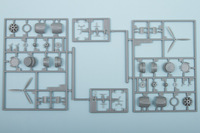 Moving on to the wing assemblies, the engine nacelles are nicely detailed, albeit a bit complex. There are two main halves that fit around a center piece that holds the radial engine face. The engine has a separate crankcase, and the whole assembly has a one-piece front cowl ring, eliminating difficult seams on the inside of the cowl. This assembly then fits onto another separate piece that connects the engine nacelle to the wing. While there is a bit more assembly here, the engineering of this setup is such that the need for filler is kept to a minimum.
Moving on to the wing assemblies, the engine nacelles are nicely detailed, albeit a bit complex. There are two main halves that fit around a center piece that holds the radial engine face. The engine has a separate crankcase, and the whole assembly has a one-piece front cowl ring, eliminating difficult seams on the inside of the cowl. This assembly then fits onto another separate piece that connects the engine nacelle to the wing. While there is a bit more assembly here, the engineering of this setup is such that the need for filler is kept to a minimum.
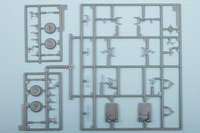 The wings themselves are split into upper and lower pieces, with separate outer wingtips and ailerons. The wheel wells are separate inserts, and the landing gear itself is very nicely detailed. These include a solid main strut with separate oleo scissors and separate actuator struts, with the main wheels split in halves. The completed landing gear meets up with positive locating holes in the wheel wells, ensuring perfect alignment. The wheel doors are simply done, and the remaining underside details include separate aileron control horns. Add the canopy and other small detail bits, and this one is also ready for paint.
The wings themselves are split into upper and lower pieces, with separate outer wingtips and ailerons. The wheel wells are separate inserts, and the landing gear itself is very nicely detailed. These include a solid main strut with separate oleo scissors and separate actuator struts, with the main wheels split in halves. The completed landing gear meets up with positive locating holes in the wheel wells, ensuring perfect alignment. The wheel doors are simply done, and the remaining underside details include separate aileron control horns. Add the canopy and other small detail bits, and this one is also ready for paint.
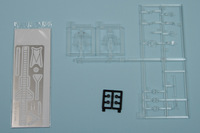
|
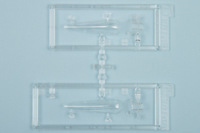
|
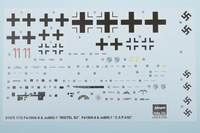 For painting and markings, both aircraft are finished in late war camouflages consisting of RLM 74, 75, and 76, with various other colors painted on in places. The first aircraft is from 6./KG 200 in Denmark, 1945, with both the Fw 190 and Ju 88 featuring a unit emblem on the nose. The Fw 190 has a '2' on the tail, while the Ju 88 has an '11' on its tail. The second option is from an unknown unit in Germany, 1945, and it features more sedate markings, but a more interesting color scheme. The Fw 190 has a small 97 on the tail and a heavily overpainted camouflage scheme. The Ju 88 has minimal markings but features a dense squiggle camouflage pattern over the upper surfaces. The decals are nicely printed and include stenciling and other fine detail bits.
For painting and markings, both aircraft are finished in late war camouflages consisting of RLM 74, 75, and 76, with various other colors painted on in places. The first aircraft is from 6./KG 200 in Denmark, 1945, with both the Fw 190 and Ju 88 featuring a unit emblem on the nose. The Fw 190 has a '2' on the tail, while the Ju 88 has an '11' on its tail. The second option is from an unknown unit in Germany, 1945, and it features more sedate markings, but a more interesting color scheme. The Fw 190 has a small 97 on the tail and a heavily overpainted camouflage scheme. The Ju 88 has minimal markings but features a dense squiggle camouflage pattern over the upper surfaces. The decals are nicely printed and include stenciling and other fine detail bits.
Conclusion
This is an excellent release from Hasegawa, combining to good models with some new extra bits to make an interesting and unique model. My thanks to Hasegawa USA for the review sample.

